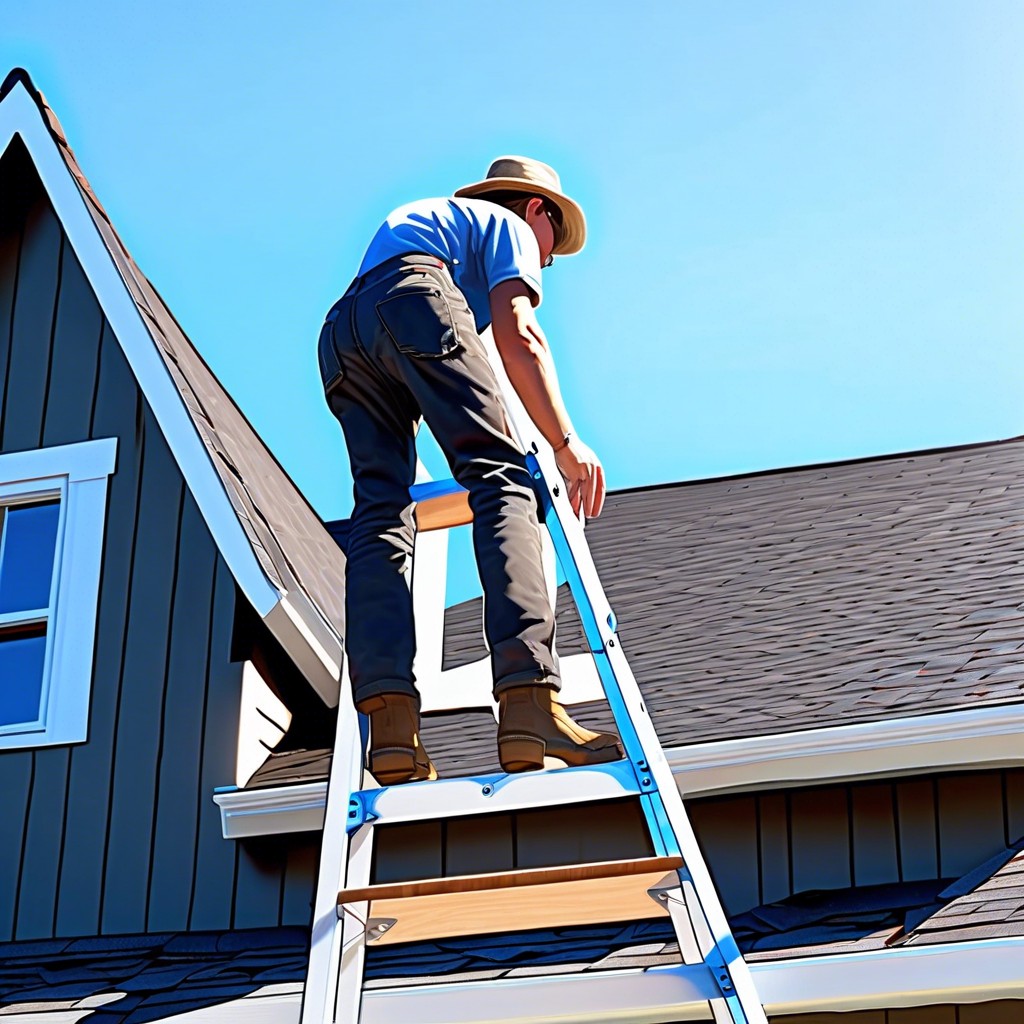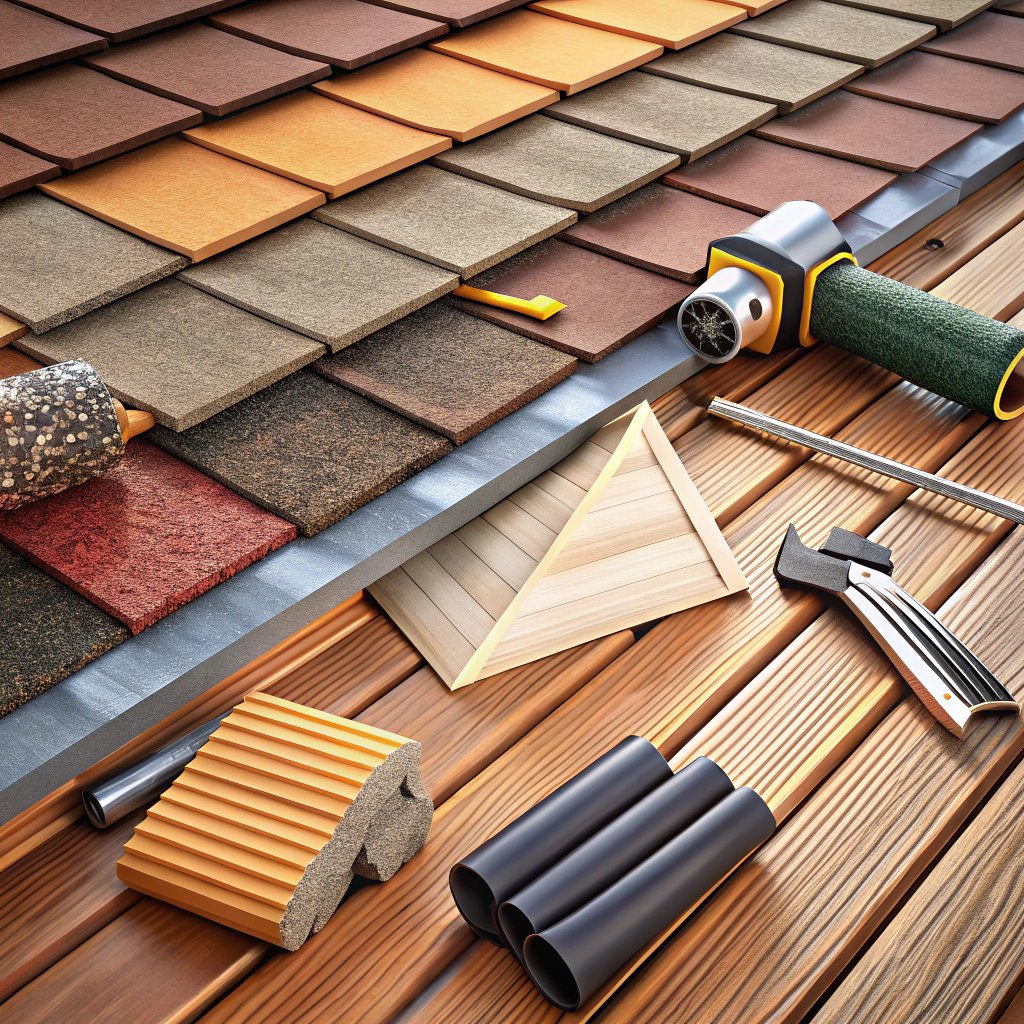Last updated on
Learn how to fix a roof leak efficiently while keeping your living room dry and your wallet happy.
Got a leaky roof bothering you? Fear not, for you’re about to embark on a quest through the mystical world of roof leaks, where detective skills meet DIY heroics. From vent boot repairs to gutter mysteries, this guide has you covered. So grab your flashlight, channel your inner Sherlock Holmes, and prepare to outsmart those sneaky raindrops. Adventure awaits!
Key takeaways:
- Inspect uphill from wet spots for leaks.
- Use a garden hose to track difficult leaks.
- Repair or replace damaged vent boots.
- Re-caulk around walls and dormers.
- Clean gutters regularly to prevent water overflow.
Look Uphill to Find Roof Leaks

Most leaks have a pesky tendency of showing up downhill from their actual source, like a drippy detective work puzzle. Water can be sneaky like that—running down rafters before deciding to drop in for a soggy surprise.
Inspect uphill from the obvious wet spot on the ceiling. Look for penetrations; any spot on your roof where you’ve got things sticking out or through—chimneys, vents, even overly committed squirrels. These are the usual suspects in your leak investigation.
Check out the roof uphill of the signs of water damage. Grab your flashlight and detective hat, you might catch the water in the act. Pay special attention to the valleys where roof sections meet—they try to keep it together, but often crack under the pressure.
Assert dominance over sneaky leaks by eliminating any debris or clutter in those areas. Give your roof a pep talk and yourself an assuring pat on the back. You’re now one step closer to stopping the soggy annoyance.
Go Into the Attic, If Possible
You know those cozy attic spaces that seem perfect for storing old photo albums? Well, it turns out they’re also your secret weapon in tracking down pesky leaks.
First, grab a flashlight and possibly a hard hat. Safety first, but fashion second, always.
Follow the trail of moisture. Water loves a good wander, so it often travels along roof decking or rafters before descending with the grace of a toddler.
Look for damp or discolored insulation. It’s like playing hide-and-seek, but with soggy cotton candy.
Watch out for those little patches of sunlight sneaking through. It’s a signal that something more substantial than sunbeams might be visiting when it rains.
Remember, attacking the problem from below just may save you a clamber onto the roof. Consider it a victory in your quest for dry ceilings.
Use This Trick to Find Difficult Leaks
Sometimes, a roof leak can be like a ninja at a costume party—hard to spot and with unexpected moves. First, grab a garden hose and ask a friend to be your trusty sidekick. While they spray water on the roof, armed with a flashlight and tireless curiosity, you stay inside to monitor for drips or sudden dampness.
Start at the bottom of the roof, systematically working your way up. Patience is key. The roof might test yours.
On stubborn leaks, try sprinkling talcum powder on suspected trouble spots. When water flows over the area, the talcum will be carried along, highlighting its path.
Of course, if neither water nor powder reveals the secret, you might have a Houdini of a leak. In which case, it could be time to call the pros, unless you’re ready to embrace the mystery.
Repair Damaged Plumbing Vent Boots
Vent boots want to be in tip-top shape, but sometimes, they act like they’ve had one too many at a shindig. Cracks or warping can invite leaks. Here’s how to handle it.
Begin by examining the rubber around the pipe. If it’s torn or cracked, it’s time for a new boot. Purchase a replacement that matches your roof type.
Gently lift shingles around the boot with a pry bar. Nails out, nails out. Remove the damaged boot. A little patience, this isn’t a boot-scootin’ dance-off.
Slide the new boot over the pipe. Ensure it’s perfectly snug, like a dachshund in a sweater.
Replace the shingles and secure with roofing nails. Don’t overdo it with the hammer or things might turn into a percussion solo. Add roofing sealant for extra resistance, ensuring your boot is leak-proof and harder to crack than a safe.
Fix Leaky Roof Vents
Grab your ladder because old man gravity doesn’t respect leaky roof vents. Often, cracks and breaks race against time to let water in. But, what’s to be done?
First things first, climb up and inspect the vent boots. Check for cracks or splits, and don’t forget to scrutinize the rubber around the pipes. Rubber gaskets might be about as stretchy as a sloth in molasses when old, so look for wear.
If the boot is damaged beyond a Band-Aid repair, it’s time to gamble on a betting win and replace it. Just pop off the old one and snug any replacement down securely. Loose is good in yoga, not on your roof.
While you’re there, examine the area for loose nails. Was that a hammer you heard calling your name? Secure any rebellious nails or screws. If needed, replace them with rubber-washer screws to help seal the deal.
Sometimes, the vent cover gets struck with the ugly stick by hail or that surprising watermelon you launched last summer. Replace any cracked covers because giving Mother Nature a weapon against your roof wasn’t in your plan.
Small cracks around the vent can flex their muscles and let water through. Use a bead of exterior silicone or a similar sealant to fill gaps, ensuring you help your roof armor up.
That’s it in a (roofing) nutshell.
Stop Leaks in Walls and Dormers
Water can be sneaky, squeezing in wherever it can. Especially around intersections like walls and dormers. Thankfully, stopping these leaks isn’t rocket science.
Start by checking the caulk between the corner boards and siding. If it’s cracked, peeled, or just plain gone, it’s time to re-caulk. A fresh seal can work wonders.
Next, assess those shoulder flashings. These capes of metal are the unsung heroes of water diversion. Keep them secured and well-tucked.
Look at the siding above the step flashing. Is it snug? Gaps allow water to enter, making homes for disruptive leaks.
Finally, dormer windows can be guilty. Their seals must be intact; if not, a leak’s a likely suspect. With a few adjustments, the pesky leaks won’t stand a chance.
Replace Damaged Step Flashing
Step flashing is like the unsung hero of roof protection, crafting a barrier against water’s relentless ambition. When it’s damaged, sneaky leaks abound.
First, pry up the shingles near the flashing to unveil the problem. If the metal is rusted or cracked, it’s time for replacements. Measure and cut new pieces to fit snugly.
Slide the new flashing pieces under the existing shingles. Superhero move: make sure they overlap down-slope to outsmart water intrusion every time. Secure them with roofing nails, ensuring they lie flat and discreetly under the shingles.
Double-check your handiwork once installed. The ultimate goal is an invisible but effective guardian, sneaky like a ninja, keeping water out without fanfare. Maintain vigilance; a little effort now saves epic flood tales later.
Patch Leaks Around Brick Chimneys
Chimneys and water: a duo that should never mix. Here are some charming ways to patch up those unruly leaks without setting your entire roof on fire—metaphorically speaking, of course.
First, check the flashing around the base. This metal sheet should cling to the chimney like a long-lost friend. If it’s peeling away—worse than my commitment to diet plans—it’s time for some attention.
Apply a generous amount of roofing caulk or sealant along the gaps or open seams. Missing flashing? You’ll need to replace it. But don’t worry; even a reluctant DIYer can do this with some tenacity and perhaps a polite curse word or two.
Examine the mortar joints. Cracks here are like sneaky leaks’ favorite hangout. Patch these up with fresh mortar to give leaks the boot.
Lastly, put a cap on it. A chimney cap can be your best defense. It keeps out not just water, but raccoons and other nosy types.
Now, off you go—be the hero your chimney has been waiting for.
Fill Small Holes
Finding a small hole in your roof doesn’t mean you should start making skylight plans just yet. Tiny punctures can often result from errant nails or aggressive squirrels with a penchant for remodeling.
To tackle these pesky little invaders:
Cut a patch of sheet metal, making sure it’s larger than the hole. Larger is better, but don’t go overboard and try to cover your entire roof in sheet metal chic.
Use a trusty roofing sealant to adhere your sheet metal patch over the hole. If you don’t have roofing sealant, bubble gum is not an option, no matter how tempting it might be.
Press firmly and ensure a secure fit. This isn’t a gentle pat—give it all the love.
Finish by sealing the edges of the patch with more sealant for the ultimate small-hole slam dunk. Keep it watertight and worry-free.
There you go—hole-y roof, no more.
Clean Out the Gutters
Clogged gutters are like that one friend who can’t keep their room clean—messy and a bit troublesome. When leaves and debris pile up like an all-you-can-eat buffet, rainwater spills over instead of flowing through the downspout. This can lead directly to water sneaking into places it’s not welcome.
Channel your inner detective! Here are some points to navigate this cleanup mission:
– Regularly inspect gutters: Especially during autumn when your roof seems to be catching leaves better than a rake.
– Remove debris by hand or with tools: But wear gloves unless you enjoy the feel of damp mystery muck.
– Flush with a hose: Check if water flows freely through the downspouts. It’s like pulling the plug in a bathtub and watching the magic.
– Install gutter guards: An excellent way to keep unwanted visitors out. Think of it as mosquito netting for your gutters.
Make sure the gutters are clear, and you’ll effectively reduce the chance of rain forming unnatural pools. Stay vigilant, stay dry!




